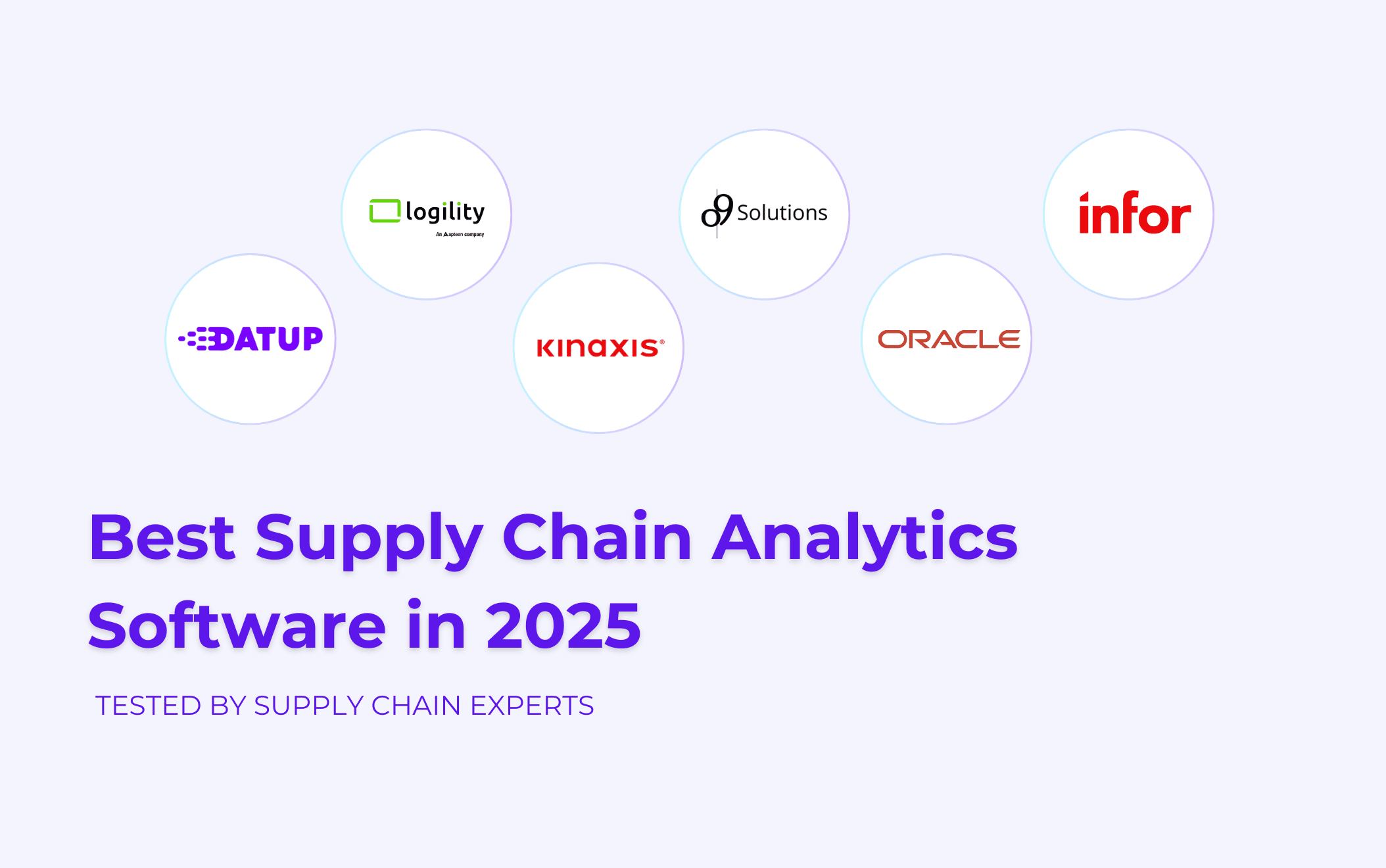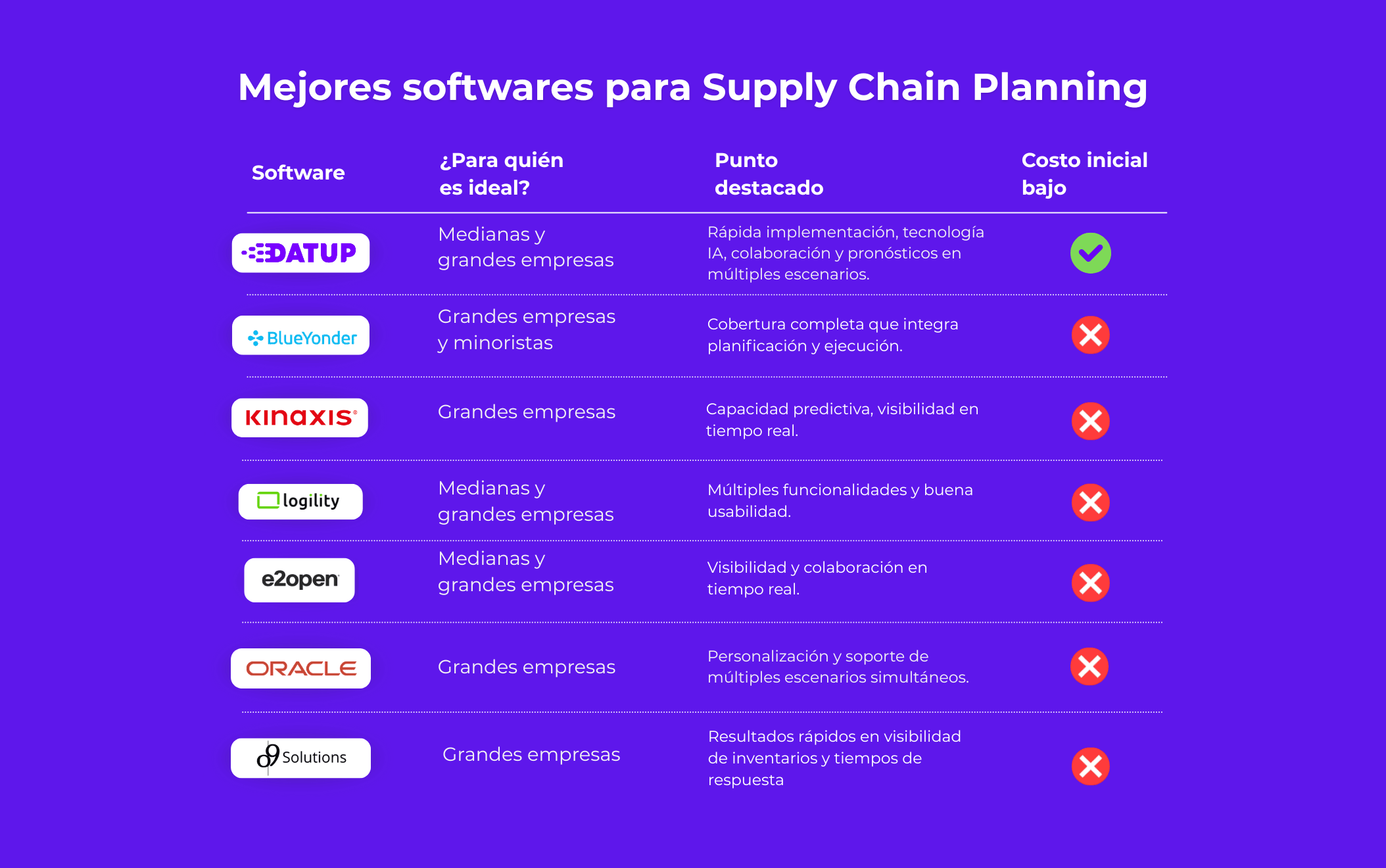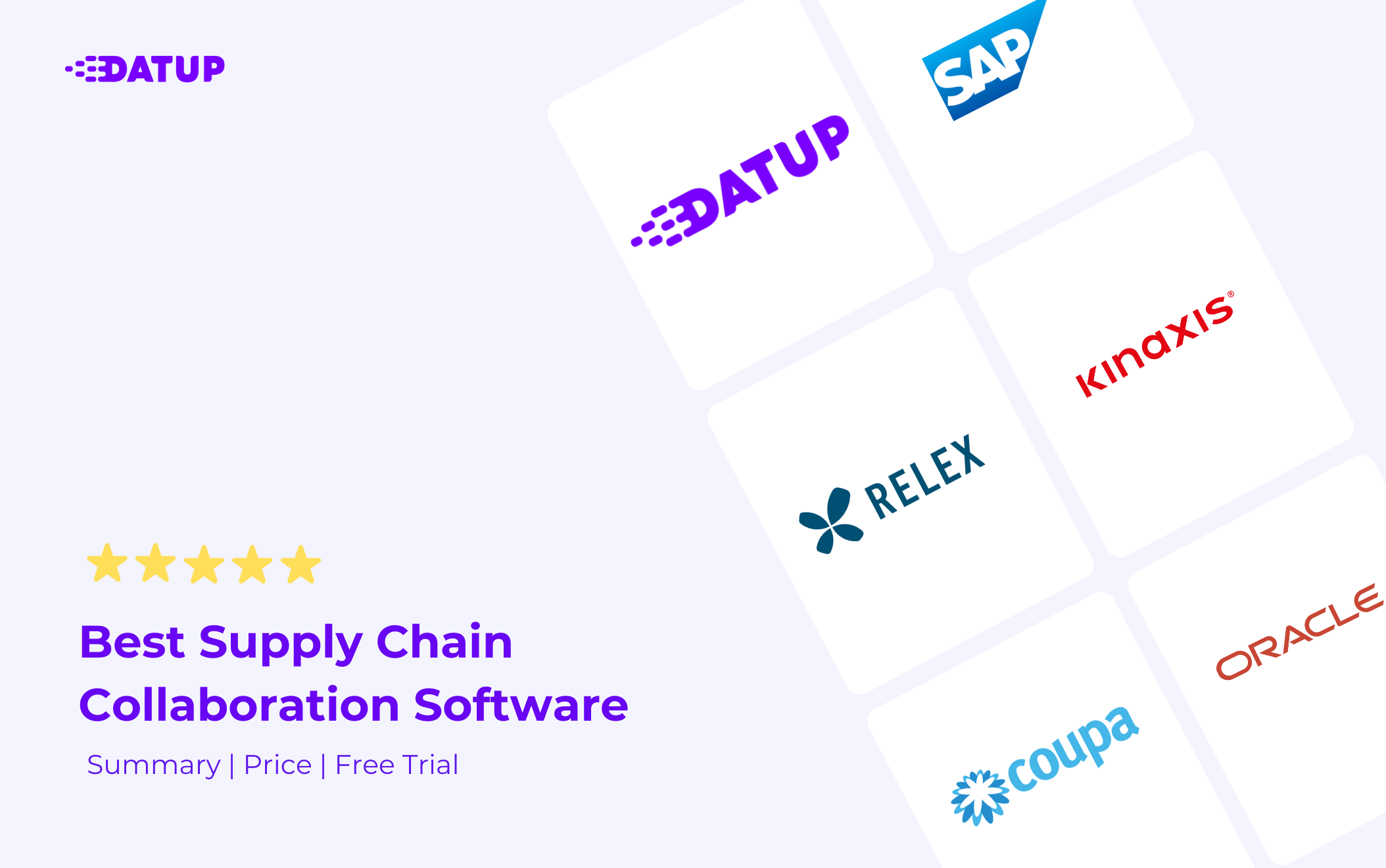Some of the most relevant available options focus on different points of the chain. To help you decide which is ideal for your company, we're going to see what each one offers comparison.
Comparison Shortlist: Supply Chain Optimization Tools in 2025
Quick decision matrix:
- Choose Datup if: You need fast ROI, high accuracy forecasting, and are a growing company with 10M+ revenue.
- Choose SAP/Oracle if: You're a large multinational requiring complete integration and have resources for complex implementation.
- Choose Coupa if: You need modular automation without SAP/Oracle complexity.
- Choose Anylogistics if: You want planning/simulation tools without operational management.
- Choose Logility if: You need AI-driven digital twin technology for retail/manufacturing.
- Choose Anaplan if: Cross-functional collaboration and financial alignment are priorities.
1. Datup AI Supply Chain Optimization Software: our choice in 2025
Datup is an AI-powered software specialized in supply chain operations.
It is one of the best options in the market currently as it relieves Supply Chain teams from operational work that takes a lot of time, maximizes sales and increases customer service by ensuring you have the right product in the right place, frees up working capital through warehouse inventory optimization and streamlines decision-making based on reliable data.
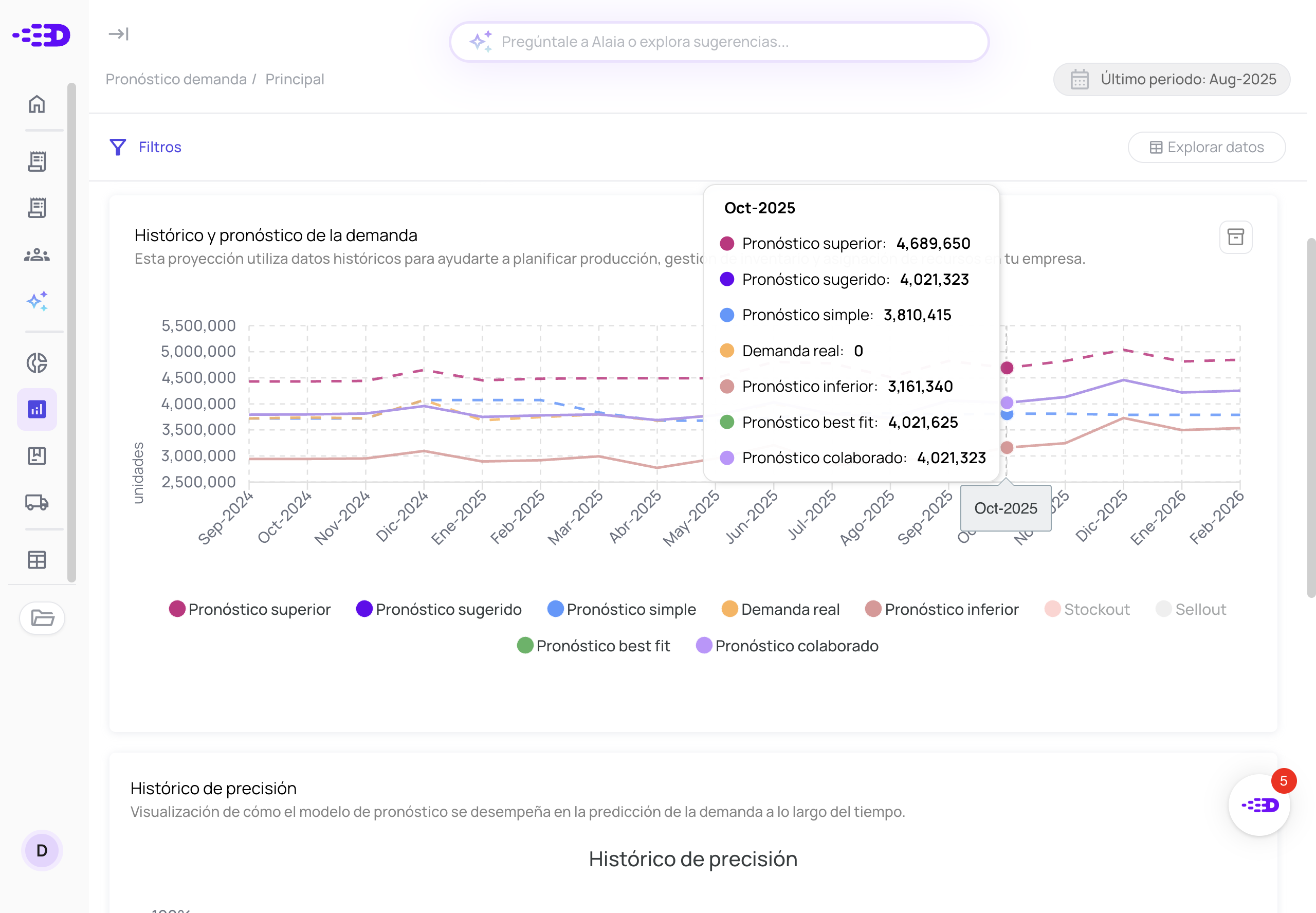
Top features
- Predicts your multilevel and multihorizon demand.
- More accurate forecasts thanks to the integration of +200 external variables.
- Collaborative S&OP / S&OE forecasts.
- Dynamic calculation of safety stocks, reorder point and lead times.
- Intelligent inventory replenishment by SKU and SKU-Location.
- Inventory optimization by distribution (warehouses and points of sale).
- Generative AI trained for Supply Chain.
Competitive Advantages of Datup
- Demand forecasts of up to +95% accuracy.
- AI-Powered Supply Chain Optimization and inventory management that allows visibility from start to finish.
- You have a conversational assistant specialized in supply chain management, whom you can consult about your data and operations quickly.
- Its implementation is the fastest in the market, taking an average of 5 weeks, even with complex data.
- It is scalable. Datup can support large volumes of data operations from complex portfolios in multiple locations, including supply chain analytics features.
- Multiple data integrations that include ERP, WMS, TMS, CRM and more.
- Datup adjusted to market changes and new trends in Artificial Intelligence and Supply Chain day by day.
- Its licensing model is a monthly paid subscription, which starts from the moment you see the results of the AI and Machine Learning models.
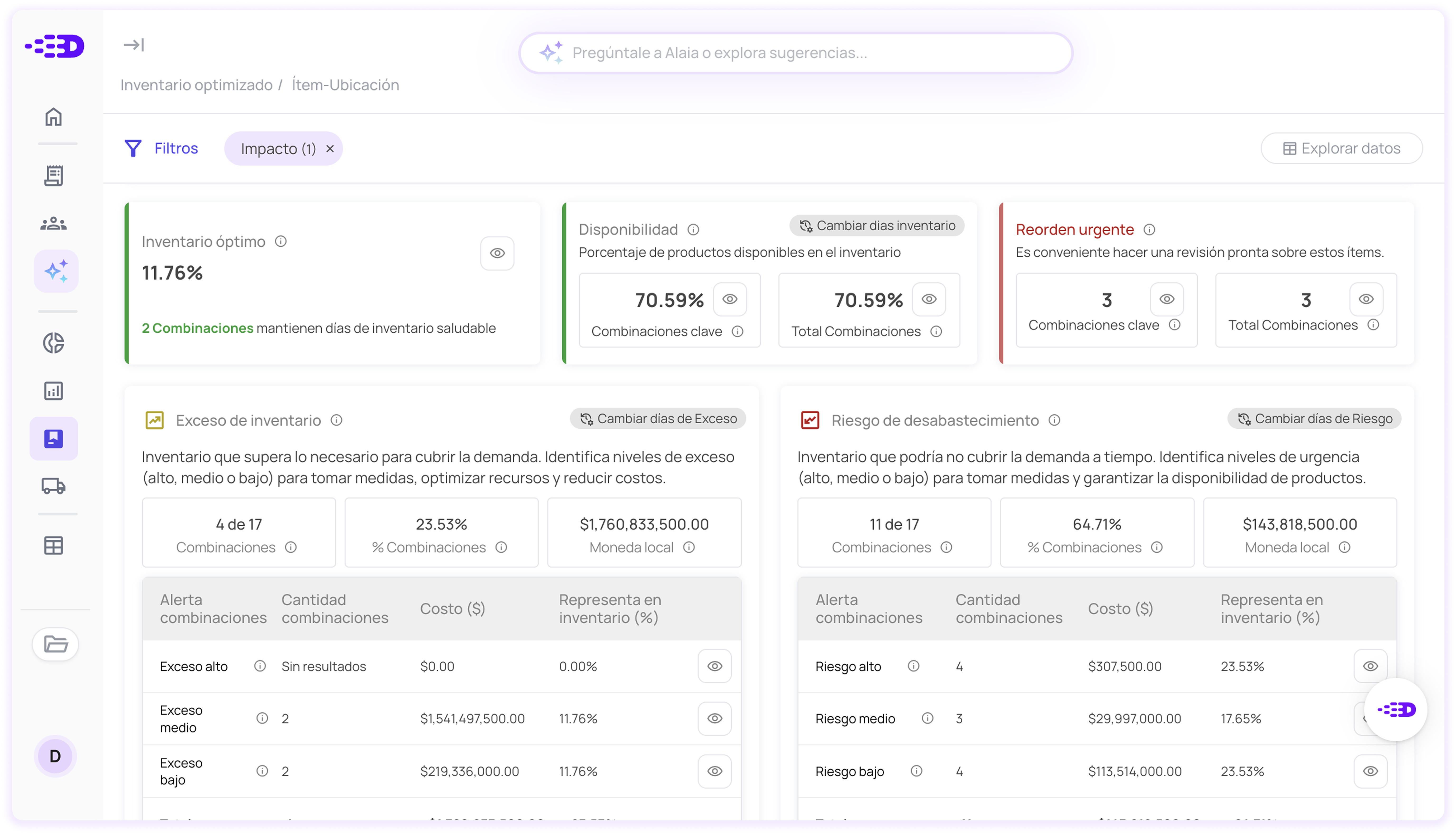
Cons
- You must have an ERP with data from at least two years to be able to see the best results.
- Being cloud-based, you need an internet connection to be able to use it.
Prices
Datup does not have standard prices, it depends on the complexity of your operations. However, if your company revenue is 10M USD annually, rest assured that Datup will be one of the most profitable options in cost-benefit.
Should you choose Datup?
Datup is ideal for growing companies, which have data in their ERP system and are also willing to take their Supply Chain Optimization operations to another level.
Currently, Datup has clients from the following sectors:
- Retail
- Consumer Goods
- Pharma
- Manufacturing
- Health
2. SAP Supply Chain Management

SAP Functionalities for the Supply Chain
SAP SCM is an option designed for companies that must handle global operations with complex processes at large scale. This platform focuses on combining real-time data with AI, providing greater precision in each link of the chain.
For this, it has the following features:
- Forecasting and demand planning, to recognize consumption patterns in advance.
- Inventory management, to minimize excesses and shortages in varied locations.
- Production planning, to synchronize resources with demand.
- Supply network optimization.
- Integration with ERP and other systems, to link different operational areas.
Advantages
Choosing SAP SCM provides operational efficiency and increases reaction capacity in changing global environments.
Among its advantages stand out:
- Greater precision in demand forecasting.
- Connection between the different areas involved.
- Process acceleration through innovation and automation.
- Great scalability capacity.
- Real-time data analysis.
Cons
What makes it attractive for large corporations is an obstacle for companies with fewer resources.
Its limitations include:
- Its high costs.
- Its technical complexity, which requires having a specialized team.
- Long implementation, which can delay return on investment.
- Great learning curve, for all those involved.
Price and Licenses
SAP SCM has a subscription and module-based contracting model, which allows it to have great flexibility during its adoption but also makes it expensive.
The factors that influence the price are:
- Quantity and type of modules chosen.
- Scale and complexity of the company.
- Customization and integration with systems already in use.
- Need for training and consultancies.
Is SAP SCM the Optimization Software for Your Company?
SAP SCM is ideal for:
- Multinationals with complex processes and integration needs.
- Companies seeking global visibility and real-time optimization.
- Businesses with resources to handle its maintenance.
For SMEs, the investment in SAP is not justified compared to more agile and accessible alternatives.
SAP SCM is one of the most complete software, so it is oriented toward large companies that want to optimize their supply chain from beginning to end.
3. Coupa
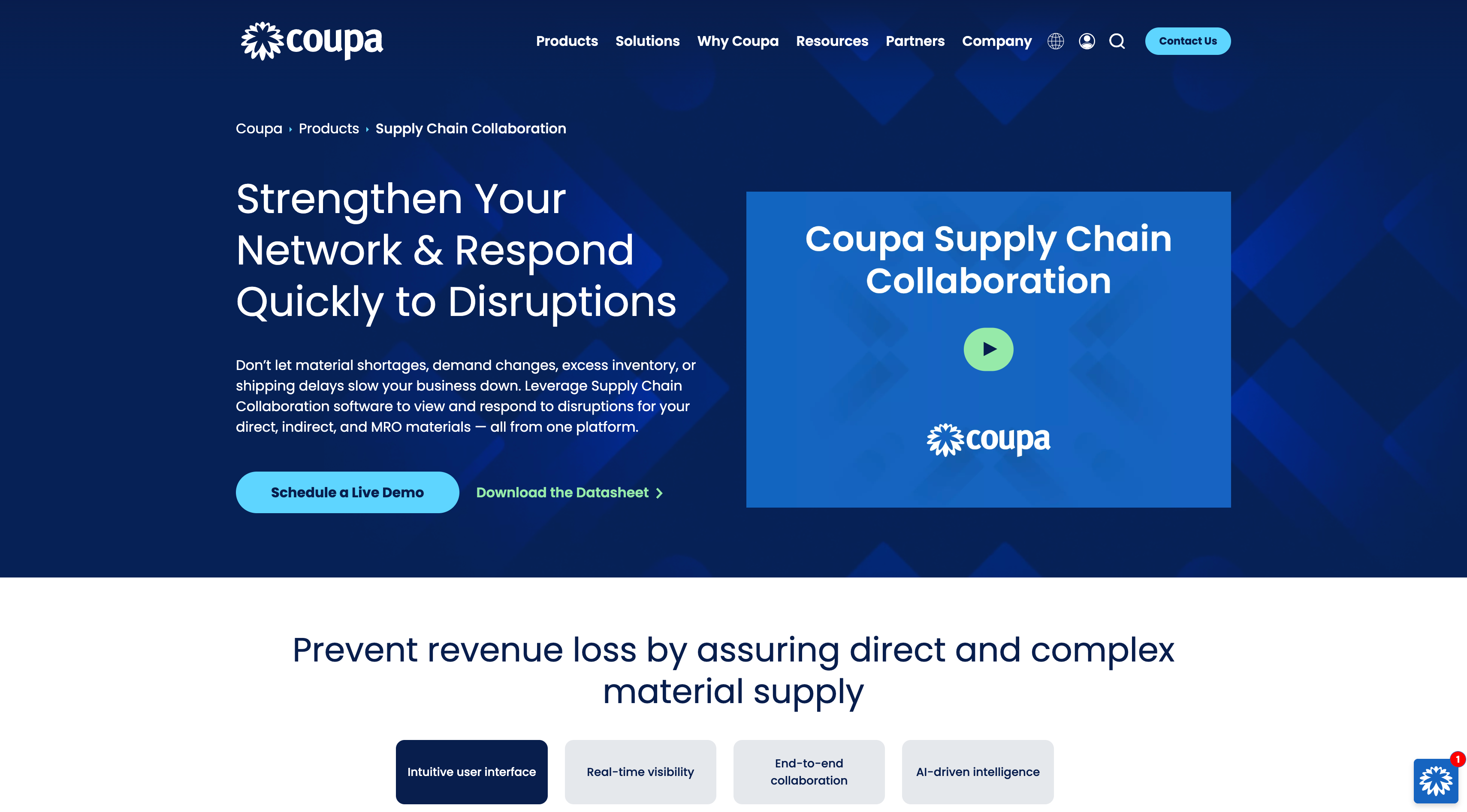
Key features
Coupa is a tool that focuses on process automation, centralized visibility, and predictive analysis. Its design is oriented to optimize its usability from beginning to end.
Among its functionalities are included:
- A centralized inventory with real-time updating, to control different locations at once.
- Forecasting and demand planning, to anticipate future demands.
- Route and logistics optimization.
- Supplier management, with performance control.
- Purchases and expenses integrated with digital approval processes.
- Advanced analytics, with dashboards to identify problems and opportunities graphically.
- Integration with ERP and other business systems, to adapt to already established companies or those that already have other tools.
Benefits of Coupa
Coupa is oriented toward companies that need operational control and scalability. The benefits of this approach are:
- Process automation, which reduces manual errors.
- Total visibility of the supply chain improvement from beginning to end.
- Efficiency in purchase and expense management.
- Scalability with modular system.
- Predictive analysis with data integration.
Disadvantages of Coupa
Besides its benefits, Coupa has some limitations that must be taken into account:
- Its interface changes between its modules, which can make its initial adoption difficult.
- Its speed is irregular, as it can take time in complex processes.
- Its implementation requires professional support.
- It has a great learning curve for new users.
These limitations have the particularity of not being throughout the entire process, but must be taken into account.
Price
Its pricing model is by subscription and then payment per modules, which makes it ideal for companies of different sizes.
The factors that determine its costs are:
- The number of modules.
- The number of users and transactions managed.
- Integration services with existing systems.
Should You Choose Coupa Supply Chain?
You should consider Coupa if:
- Your company is medium or large and needs to centralize its operations without the complexity of more complete options.
- You seek automation and control in a single system.
- You work in retail, global manufacturing, and logistics.
Coupa offers advanced automation with modular flexibility, ideal for companies that need to improve quickly.
4. Oracle Supply Chain Management

Oracle Fusion SCM Cloud combines artificial intelligence, machine learning, and advanced automation. It is a comprehensive solution that connects transportation, inventories, orders, international commerce, and regulatory compliance in the same infrastructure hosted in the cloud.
What characteristics does Oracle have for Supply Chain Optimization?
Its main functionalities include:
- Transportation and order management to reduce delays.
- Global commerce and compliance, to comply with local and international regulations.
- Dynamic chain optimization, which allows reacting to unexpected events.
- Process automation, eliminating repetitive manual tasks.
- Multi-ERP and multi-system integration.
Oracle is designed for companies with international presence.
Benefits of Oracle
The benefits of Oracle Supply Chain Optimization are oriented toward anticipating regulatory changes, logistical disruptions, and movements in demand.
Among its main benefits are:
- Comprehensive and centralized visibility to identify bottlenecks and issues.
- Cost reduction as it optimizes routes and resources.
- Greater agility in the face of unforeseen events.
- Tools for regulatory compliance, which minimize legal risks and customs delays.
- Multilevel integration capacity, avoiding duplicate data and improving the relationship between geographically distant areas.
Limitations of Oracle for Supply Chain Optimization
Its technical complexity and implementation cost make it an option that is not suitable for any company.
Its limitations are:
- Migration to the cloud, with long phases.
- High costs of customization and support.
- Needs specialists, for its administration.
- Slow integration that delays return on investment.
Oracle is designed for companies that can finance complex projects.
How much does Oracle cost?
Oracle SCM Cloud has a model based on subscription, modules, and number of users. This allows flexibility for organizations seeking to exploit its full potential.
Its costs are determined by:
- The number of users, which can scale very quickly depending on the size of the companies.
- The number of contracted modules.
- The level of customization.
- Additional services.
Is Oracle for your company?
Oracle Supply Chain Optimization is ideal for companies that:
- Are in several countries and need global visibility.
- Have complex processes that need to be automated.
- Want to optimize logistical costs.
5. Anylogistix
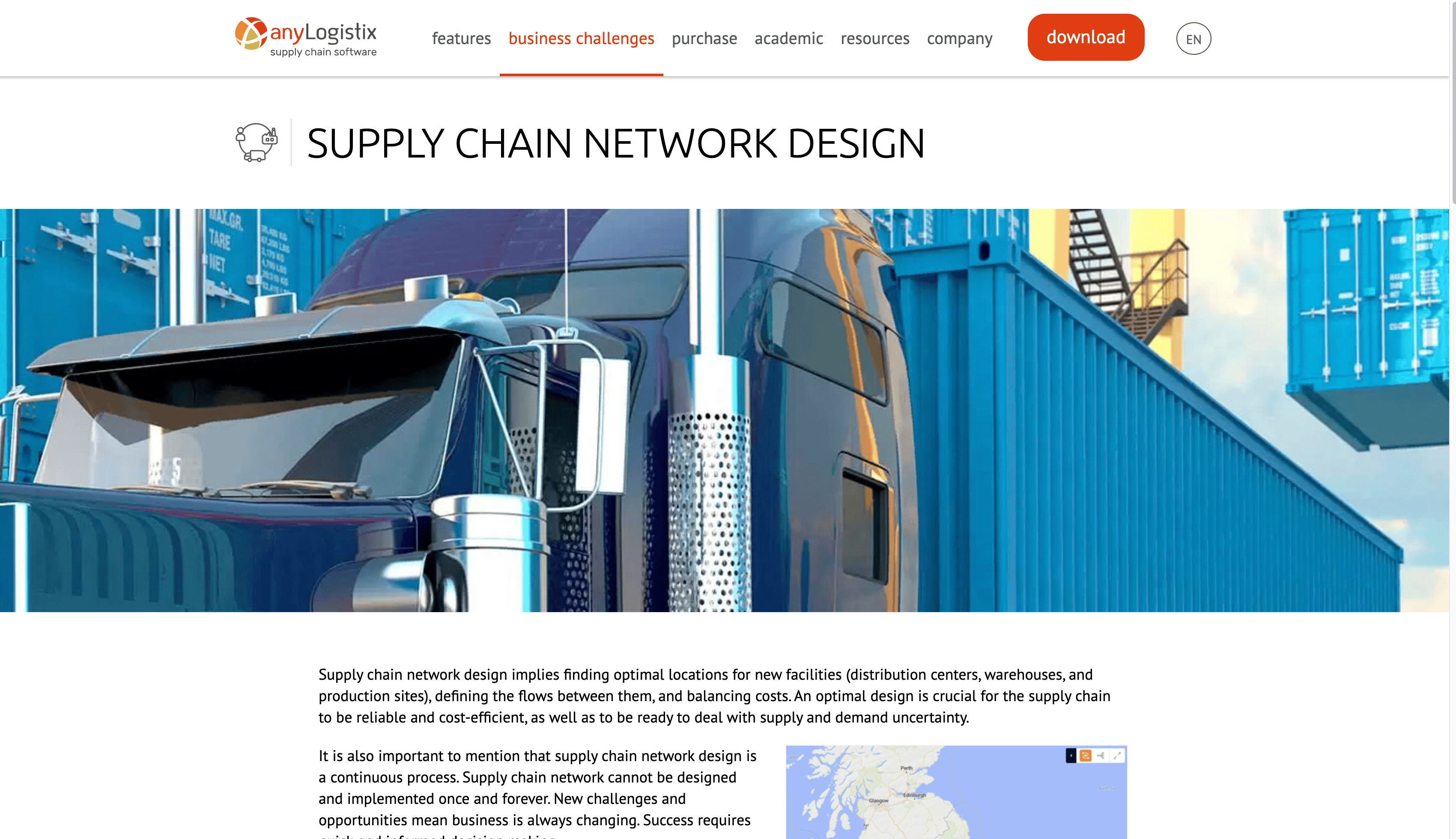
Anylogistix focuses on allowing companies to experiment, analyze scenarios, and design more efficient supply networks before making strategic decisions in the real chain.
Main Functionalities
This software has a unique visual and interactive resource, which makes access to the distribution network easier under different conditions.
Its key functionalities are:
- Dynamic supply chain simulation, to foresee the impacts of changes in demand or productive capacity.
- "What-if" analysis, to see multiple fictitious scenarios before making decisions.
- Inventory optimization, to avoid excesses and stock breaks.
- Logistics network design.
- Visual model based on maps, easy to understand for all those involved.
- Integration with external data, to make comprehensive decisions.
Benefits
This tool allows simulating different fictitious scenarios, which allows identifying risks and finding increasingly efficient configurations for the supply chain.
Its benefits include:
- Its ease of adoption, it is independent but compatible with Excel and ERPs.
- Error reduction, reduces the need to use manual tools.
- Visualization of complex data thanks to its visual and interactive resources.
- A free version.
Anylogistix establishes itself as a kind of laboratory, where companies can test hypotheses and strategies safely, before applying them in their supply chains.
Limitations
Its most significant limitations are:
- It does not offer advanced administrative modules, so it is not as scalable as other options.
- Its use is limited to daily operation, as it does not allow automating complex processes.
- It does not offer operational control, but modeling for forecasting.
Anylogistics is a great tool for planning, but not for managing a supply chain from end to end.
Costs and Plans
Regarding costs, Anylogistics offers several options:
- Personal use, it is free and ideal for initial testing.
- Subscription license, with full access.
- Commercial version with perpetual payment.
Is Anylogistics the Ideal Supply Chain Optimization Software for Your Company?
Anylogistics is ideal for companies seeking strategic planning tools, and not so much operational management systems.
It is a good option if your company:
- Is a consulting firm or has strategy teams, that need to consider different scenarios.
- Is a medium-sized company, that needs to optimize its logistics network without making large investments.
- Is focused on innovation, and seeks to have the possibility to test before implementing.
If you need control and process automation, you will need to complement it with another tool.
6. Logility

Logility has an AI-first approach, using artificial intelligence as the core of its functionalities.
Outstanding Aspects of Logility
It works with a digital twin of the real supply chain, to simulate scenarios, anticipate, and evaluate the impact that certain decisions would have on the real operation.
Its outstanding aspects are:
- AI forecasting, to adjust demand planning with predictive models.
- Dynamic inventory management in many locations.
- Route and transportation optimization.
- "What-if" scenarios and digital twin, to experiment in a virtual environment before implementing in the real chain.
- Collaborative S&OP planning, to integrate the different areas involved.
- Agile integration with other systems.
Benefits of Logility for Supply Chain Optimization
Its main role is to convert data into actionable decisions, with AI-based predictions.
This offers several benefits:
- Real-time visibility, react in real time.
- Inventory effectiveness.
- Flexibility, sustained in virtual scenarios.
- Collaboration between areas.
- Automation of repetitive supply chain optimization process.
Cons of Logility
Logility is solid and flexible, but can be complex for more traditional companies:
- Requires training, in AI and simulation.
- Takes adaptation time, especially when involving new areas.
- Is difficult to implement for companies with low digital maturity.
Logility demands great organizational capacity to obtain its full potential.
Prices and Licenses
Its scheme is subscription-based. It has a modular and scalable format that allows adding modules according to their needs.
Its final price is determined by:
- The number of modules chosen.
- The size of the company.
- The need for support and customization.
Is Logility the Supply Chain Optimization Tool for Your Business?
Logility is ideal for companies that want to be more flexible, faster, and more adaptable.
It is a good option for:
- Retail companies, where precision in demand is decisive.
- Manufacturing and consumer goods, with high volumes and dispersed operations.
- Companies that want to be more comprehensive.
It is not the best option for traditional companies, as its functionalities may exceed their needs.
7. Anaplan

Anaplan is a collaborative platform. Its strength lies in its ability to connect data, finances, and supply chain processes in a single dynamic environment.
Key Characteristics of Anaplan for Supply Chain Optimization
It has a cloud-based architecture and an approach directed toward creating customized models that distinguish it from its competitors.
Some of its main characteristics are:
- It allows collaborative planning in real time by integrating varied and different areas and teams.
- It has "what-if" scenario analysis, to review the impact of decisions before making them.
- It has forecasting and inventory optimization.
- It offers customized plans that adapt to the particularities of each company.
- It integrates with financial and operational systems, to align corporate strategy.
Anaplan is ideal for those seeking to respond with agility to volatile environments.
Benefits of Anaplan
Anaplan offers a centralized space to build integrated plans available to the entire chain.
Its benefits are:
- Its great adaptability capacity.
- The development of complex plans, integrating finance, operations, and logistics.
- Great strategic alignment, which allows connecting business objectives with supply chain plans.
- Comparison of multiple scenarios (S&OP), to make informed decisions.
- Shared visibility between areas.
Anaplan moves from reactive planning to proactive planning by achieving improved internal coordination.
Limitations
However, when working with this tool, some challenges arise to take into account:
- Problems when editing simultaneously.
- Great learning curve, especially for new users.
- Limitations in concurrent actions, which limit its usability in complex situations.
- Demands initial training.
Those who use Anaplan must have a team prepared for its implementation.
Prices and Licenses
Its licensing model is payment per user and per module, so it is scalable and adaptable to the size of companies.
The costs are determined by:
- The number of active users and the permissions assigned to each one.
- The number of modules.
- The level of customization and support desired.
Should you choose Anaplan to optimize your Supply Chain?
Anaplan is ideal for companies that:
- Want supply chain plans in a flexible and fast manner.
- Need to compare scenarios before making decisions.
- Need a collaborative environment for their financial, logistical, and operational processes.
- Escape models with long development processes.
However, it is not a good option for small companies or those with low digital maturity, as its difficulties could become major obstacles.
Top benefits of a supply chain optimization software
The need to reduce costs, increase control, and respond agilely to changes in demand makes supply chain optimization software decisive tools for any company that wants to remain active, regardless of its size.
Its greatest value is that they allow transforming the supply chain into proactive data-based systems that, moreover, stop depending on manual processes. These tools allow anticipating problems while generating new intervention opportunities.
Companies that adopt this software obtain several benefits:
- Greater Visibility of the Chain from Beginning to End
With real-time dashboards, these tools organize dispersed information and offer centralized control.
- Great Forecasting Capacity
AI and predictive models reduce uncertainty at the time of planning, while allowing production and distribution to be adjusted according to forecasts.
- Cost Reduction
Different optimization processes eliminate unnecessary expenses, minimize errors, and improve resource use.
- Agility in the Face of Disruptions
Scenario simulation allows responding to real market changes before they happen.
- Collaboration Between Areas
By integrating finance, operations, logistics, and planning, corporate coordination is improved.
- Automation of Repetitive Processes
These tools eliminate manual tasks, freeing time for strategic tasks.
Supply Chain Performance Optimization software helps align objectives with daily execution by:
- Providing reliable data for long-term planning.
- Reducing delivery times and increasing customer satisfaction.
- Ensuring stable operations in crisis contexts.
What features to look for in supply chain optimization software?
There are essential functionalities that all supply chain optimization software must have regardless of the organization's size.
Some of the essential functionalities are:
Advanced forecasting
To generate accurate predictions using AI, machine learning, and historical analysis. This functionality allows adjusting inventories and production with lower risk of excess or stock breaks.
Real-time inventory management
To monitor different locations at the same time, reducing costs and guaranteeing stock.
Production planning
To coordinate the use of resources, with production lines based on anticipated demand.
Transportation and logistics optimization
Modules that optimize routes, transportation, and costs provide efficiency and improve customer service quality.
Integration with ERP and other systems
Being able to connect with other platforms or CRM ensures data consistency and eliminates duplicates.
Scenario simulation
This function is critical to anticipate the impact of decisions on the chain.
Advanced analytics and dashboards
To have a clear and practical visualization of data and be able to make quick decisions backed by information.
Besides these basic capabilities, there are other functionalities that make some software stand out:
- Digital twins of the supply chain, allow simulating a virtual logistics network to test before applying decisions in the real chain.
- AI supplier management, which evaluates performance.
- Approval and purchase automation, to reduce administrative times.
- International compatibility, essential for global companies that must comply with various regulations.
The key is to choose an option that has the basic functions but also has others that respond to each company's needs.


![7 Best Supply Chain Optimization Software [2025]](https://cdn.prod.website-files.com/67aa77fdde6ccbbc569579f4/68fa6c1685b3659209f8e5a8_Best%20AI-Powered%20Supply%20Chain%20Management%20(SCM)%20Software%20for%202025%20(3).png)


